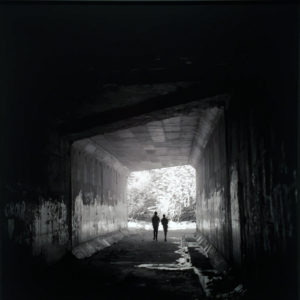Constructed spaces, both virtual and actual, link the works of Barry Anderson and Timothy Paul Myers (in collaboration with Andrew Barnes).
In the front galleries, Kansas City-based multimedia artist Barry Anderson presents projections, stills and monitor based works (in the front galleries) that show labyrinthine journeys through invented spaces. The camera pans, twists and turns, moving forward and back, darting left, then right down corridors and hallways, exploring every aspect of the environment. Collectively titled Fragments of Space, (all works 2016) each digital video animation pictures a different environment defined by color and/or natural reference and is identified with a bracketed subtitle: [DeepRed], [ClearRose], [BlueMoon] and [WaterLab].
Fragments of Space [WaterLab] is a three-minute, 40-second loop through a dark, maroon-toned, ambiguously reflective space filled with shallow shimmering water. The depiction alludes to the bowels of a ship or a flooded building in which treasures may be hidden. White objects appear—a Minotaur’s head and other sculpted elements—but the camera never lingers on them, creating an unresolved relationship between the moving and the static elements that exist within the digitally constructed architecture.

Barry Anderson, Graffiti Hall, 2016. ©Barry Anderson, courtesy of Walter Maciel Gallery.
Anderson juxtaposes these video animations with a suite of four black-and-white photographs that evoke more intimate and personal moments. In Lake Superior, sky melds with calm waters surrounding the back of a boy submerged almost to his neck, and in Graffiti Hall, two silhouettes are photographed exiting a concrete tunnel moving toward an illuminated natural landscape. The still images present isolated moments frozen in time, a poignant counterpoint to Anderson’s animated works that depict continuously morphing spaces from which there is no escape.
While Anderson’s work is digitally rendered and cool, Timothy Paul Myers’ The Living Room (2016), installed in the back gallery, is hand crafted, soft and tactile. Myers, who collaborates with Andrew Barnes, has meticulously created a life-sized replica of a wall in an imagined living room, complete with fireplace, reading chair, books, a hanging lamp and myriad details—flowers, vases, boxes, empty bottles, lint roller and pistachio shells—all covered in gray felt. Though Myers has stripped the room of color, presenting the facade as a monochrome, it is nonetheless bursting with energy. This stems from the huge array of flowers cascading from the fireplace and spilling out onto the area that marks the boundary of the piece. Imagining the fireplace’s soot and wooden embers transformed into blossoming flowers—a mixture of lilies, roses and sunflowers—flowing from an unseen chimney is a whimsical delight. The Living Room in many ways feels like a surreal black-and-white photograph brought to life. Two smaller works hang on an adjacent wall, and while also made from felt, their bright pink is a vivid contrast to the larger gray installation. In these pieces a small selection of what could be found on a mantel—banal items associated with home and family life—are carefully, albeit idiosyncratically arranged.
Myers’ enigmatic and obviously time-consuming installation is a beautiful complement to Anderson’s projections as both artists carefully construct imagined spaces based on careful observation, yet in reality both are places that could never exist.



















0 Comments